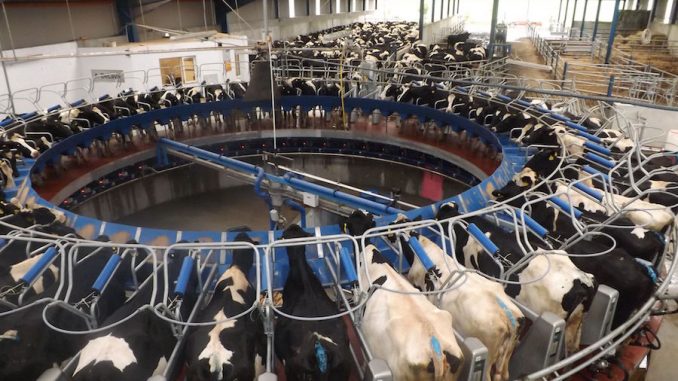
What type of milk do you drink? Milk packed with steroids, sex hormones and malaria medication, or wholesome, natural milk that comes with an enormous list of health benefits including helping you lose body fat?
A new study has revealed that a glass of milk can contain a mixture of as many as 20 painkillers, antibiotics and growth hormones. Using a highly sensitive test, scientists found the dangerous chemicals in samples of both cow and goat milk intended for human consumption.
The results show how man-made chemicals are now found throughout the food chain. The highest quantities of medicines and hormones were found in cow’s milk.

BYPASS THE CENSORS
Sign up to get unfiltered news delivered straight to your inbox.
You can unsubscribe any time. By subscribing you agree to our Terms of Use
Latest Video
“Researchers believe some of the drugs and growth promoters were given to the cattle, or got into milk through cattle feed or contamination on the farm … [The] breakdown … revealed that cow’s milk contained traces of anti-inflammatory drugs niflumic acid, mefenamic acid and ketoprofen … It also contained the hormone 17-beta-estradiol,” the Daily Mail reported.
Dr Mercola reports:
Milk is thought of as a wholesome food, which is why so many parents give it to their children with every meal. And the truth is, it is wholesome when it’s in its natural form and sourced from cows fed non-contaminated grass and raised in clean conditions.
Unfortunately, the milk that winds up in most Americans’ glasses is far from this unadulterated state and, as the study above revealed, instead may be a veritable chemical cocktail.
What’s Really in Your Milk?
European researchers used a highly sensitive test to determine what types of medications could be found in a variety of milk (cow, goat and human breast milk), and they hit the chemical jackpot. Medications used to treat diseases in both humans and animals were revealed.
Among the drugs and hormones detected were:
Anti-inflammatories (niflumic acid, mefenamic acid, ketoprofen, diclofenac, phenylbutazone, naproxen, flunixin, diclofenac) Antibiotics (florfenicol)
Sex hormones (17-beta-estradiol)
Steroid hormones (17-alpha-ethinylestradiol)
Anti-malaria drugs (pyrimethamine)
Anti-fungal drugs (triclosan)
Natural hormones (estrone)
While all types of milk tested contained chemicals, including breast milk, cow’s milk contained the highest levels. Some of these drugs and hormones were given to the cows directly, while others were likely ingested from the cattle food or contamination on the farm.
The truth is, chemical contaminants are now showing up throughout the entire food chain, which is why it’s so important to choose your food wisely, from farmers who make efforts to avoid toxins like these and certainly don’t add to the problem by supplying them directly. Unfortunately, if you buy your milk in most supermarkets, you can rest assured that it will probably contain contaminants you’d be better off avoiding.
Big Dairy Routinely Gives Drugs to Cows
It’s hard enough to raise pure food these days considering that environmental pollution is rampant, so finding pure water and soil can be a challenge. But in the case of big dairy, they are contributing to this pollution and taking no steps to ensure that their cows, or the milk they produce, are free from drugs and hormones. In fact, they readily feed these chemicals to the cows; it’s an integral part of the farming method on CAFOs (confined animal feeding operations).
For instance, did you know that every year U.S. inspectors find illegal levels of antibiotics in dairy cows? And that when the U.S. Food and Drug Administration (FDA) made plans to test milk from cows that had shown high levels of drug residues repeatedly, the dairy industry protested … and the FDA backed down and postponed the testing?
It’s true.
And now, instead of looking out for Americans’ health and taking action against what could be dangerously high levels of antibiotics in milk (not to mention contributing to the spread of antibiotic-resistant disease), they are planning to “confer with the industry before deciding how to proceed,” the New York Times reported. Dairy cows raised on CAFOs also eat grains that are heavily treated with chemicals that are transferred to the milk.
Do You Want Hormones With Your Milk?
There’s also the issue of recombinant (genetically engineered) bovine growth hormone (rBGH), which is used to significantly increase milk production in cows. Treated cows can produce as much as 15-25 percent more milk. But this increase in milk production, and hence profit, has hidden costs, namely the cows’ and your health.
For nearly two decades, the FDA has held on to their initial finding that there’s “no significant difference” between the milk of cows given genetically modified artificial growth hormone and those that aren’t. But the milk produced by these cows has been shown to be anything BUT identical to untreated milk.
Hormone-treated milk is different from non-treated milk because:
1. It contains increased levels of the hormone IGF-1, which promotes cancer tumors. According to Dr. Epstein, professor emeritus of Environmental and Occupational Medicine at the University of Illinois School of Public Health, and Chairman of the Cancer Prevention Coalition, excess levels of IGF-1 have been incriminated as major causes of breast, colon, and prostate cancers
2. Hormone use “induces an unnatural period of milk production during a cow’s “negative energy phase.” Milk produced during this stage is considered to be low quality due to its increased fat content and its decreased level of proteins, an Ohio court, which ruled that milk in Ohio can still bear an “rbGH-free” label, stated.
3. It contains increased somatic cell counts (SCC’s). This means the milk contains more pus, which makes it turn sour more quickly. Increased SCC count also affects the milk’s taste, smell, texture and color. Raised SCC levels is typically caused by the high incidence of mastitis in rBGH-injected cows
Further, Dr. Epstein has pointed out several additional differences between rBGH milk and untreated milk and all of these factors can cause or contribute to health problems:
1. Contamination by the GM hormone rBGH
2. Contamination with illegal antibiotics and drugs used to treat mastitis and other rBGH-induced disease
3. Increased concentration of the thyroid hormone enzyme thyroxin-5′-monodeiodinase
4. Increased concentration of long-chain and decreased concentration of short-chain fatty acid
5. A reduction in levels of the protein casein
Want Better Milk? This Option is Even Superior to Organic
You may be thinking that the solution to purer milk is to buy organic. Organic milk is clearly better as organic dairy cows will not be given rBGH or routine antibiotics … but it will still have been pasteurized, and this seriously compromises the quality of the milk.
A better option is grass-fed RAW milk, which is nearly always better than organic milk if it is purchased from a conscious farmer. In that case, it may not be certified organic, but it will essentially be organic anyway, and drinking your milk raw is the superior choice. Milk from grass-fed cows, unlike grain-fed cows, will be high in CLA that is loaded with many health benefits including helping you lose weight.
I typically have four tablespoons of raw grass-fed butter a day and that has 1,000 mg of CLA.. So if you are having the real whole food with the beneficial fat you do not need the supplement.
Pasteurization transforms the physical structure of the proteins in milk, such as casein, and alters the shape of the amino acid to one that your body is not equipped to handle. The process also destroys the beneficial bacteria typically found naturally in milk and drastically reduces the micronutrient and vitamin content.
Pasteurization also destroys part of the vitamin C in raw milk, encourages the growth of harmful bacteria, and turns milk’s naturally occurring sugar (lactose) into beta-lactose. Beta-lactose is rapidly absorbed in the human body, with the result that hunger can return quickly after a glass of milk — especially in children. The pasteurization process also makes insoluble most of the calcium found in raw milk. This can lead to a host of health problems in children, among them rickets and bad teeth. And then there’s the destruction of about 20 percent of the iodine available in raw milk, which can cause constipation.
When pasteurized milk is also homogenized, a substance known as xanthine oxidase is created. This compound can play a role in oxidative stress by acting as a free radical in your body.
Raw milk, on the other hand, contains good bacteria that are essential for a healthy digestive system, and offers protection against disease-causing bacteria … so I don’t recommend you waste a penny on pasteurized organic milk — seek out milk (and other dairy products) from a reputable raw dairy instead.
Tips for Finding High-Quality Raw Milk
The quality, purity and cleanliness of your milk is only as good as the farm it came from, which is why I want to explain how to identify high-quality sources of raw milk. Right now, only 10 states permit the retail sale of raw milk, and each state sets its own standards. California, specifically, has its own special set of standards for raw milk for human consumption, in which farmers must meet or exceed pasteurized milk standards, without pasteurizing.
Finding raw milk is NOT that hard and nearly everyone should be able to locate a supplier if you are persistent enough. You can find raw milk retailers in California by using the store locator available at www.OrganicPastures.com, and for other areas, check out the Campaign for Real Milk Web site. You can also look here to find out the legal status of raw milk in the U.S. state or country where you live.
Since many raw milk producers are very small farms, and the standards that do exist vary from state to state, how do you go about identifying solid, high-quality producers of raw milk if you can’t just buy it in a store nearby? There are a few general conditions you should look for, including:
- Low pathogenic bacteria count (i.e. does the farmer test his milk regularly for pathogens?)
- The milk is quickly chilled after milking
- The milk comes from cows raised naturally, in accordance with the seasons
- The cows are mainly grass-fed and well cared for
The cows are not given antibiotics and growth hormones to increase milk production
If you’re thinking about purchasing milk from a small farmer, it would be very wise to visit the farm in person. Look around and ask questions, such as:
- Do the farmer and his family drink the milk themselves?
- How long has he been producing raw milk?
- Are the cows clean?
- What conditions are the cows raised in?
If a cow is covered in filth and manure, stinks, is wet and cold and doesn’t look particularly comfortable, that could be a warning sign that her milk is less than ideal for consumption, even if it’s from a small, local farm. Virtually all cows raised on CAFOs will be raised in these types of poor conditions, which is another reason I don’t recommend consuming milk that comes from these Big Dairy sources


